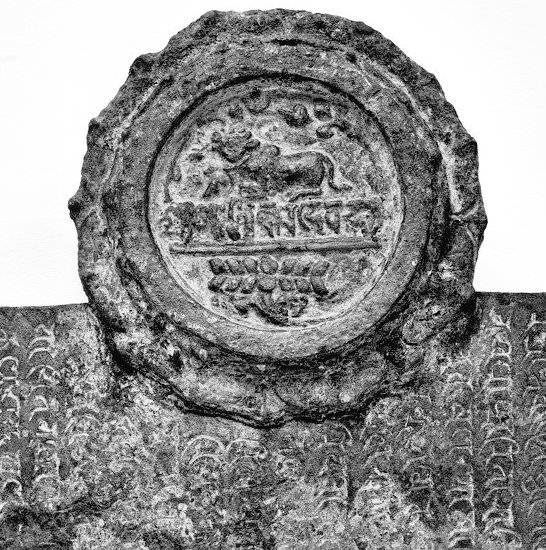The initial phase of Temple Construction activity in Odisha was led by the Benevolent rulers of the Bhaumakara Dynasty. It was replaced by the Somvanshi around the 10th-Century which continued the Same-Manner.
Royal-Seal of Bhaumkara Dynasty depicting Nandi & Lotus
Royal-Seal of Bhaumkara Dynasty depicting Nandi & Lotus
History of
Odisha in 8th-CenturyAD marked the Emergence
of a PowerfulDynasty named as Bhaumakaras. The Bhaumakara Dynasty ruled for nearly 2-Centuries &
Established a VastKingdom known as Toshali. The
kingdom was Extended from Kongodamandala
in South-Dandabhuktimandala in North..
Odisha in 8th-CenturyAD marked the Emergence
of a PowerfulDynasty named as Bhaumakaras. The Bhaumakara Dynasty ruled for nearly 2-Centuries &
Established a VastKingdom known as Toshali. The
kingdom was Extended from Kongodamandala
in South-Dandabhuktimandala in North..
Entire Odisha including SouthWestern part of
Midnapore (WestBengal) was under their
Sway. 6-Females of the Bhaumakara Dynasty ruled over Odisha.
In Ancient India Wives of Kings didn’t
usually succeeded to their Husband’s Throne, when
a King died without leaving any Male issue....
Midnapore (WestBengal) was under their
Sway. 6-Females of the Bhaumakara Dynasty ruled over Odisha.
In Ancient India Wives of Kings didn’t
usually succeeded to their Husband’s Throne, when
a King died without leaving any Male issue....
....often
his Chief Queen adopted a Boy as Her Son. We get
number of instances of Queens acting as Regents
or Governors in the History of Ancient India, but
the History of Odisha in the Ancient Odisha
however tells a Different Story. During the Bhaumakara Dynasty
rule we come....
his Chief Queen adopted a Boy as Her Son. We get
number of instances of Queens acting as Regents
or Governors in the History of Ancient India, but
the History of Odisha in the Ancient Odisha
however tells a Different Story. During the Bhaumakara Dynasty
rule we come....
....across 6-Numbers of Reigning
Queens ruled as de-Jure & de-Facto Sovereignty.
Their Sovereign status is Evident of Imperial title
as Maharajadhiraja & Paramabhattarika. These Six Females were the strongest Warriors of this Bhaumakara Dynasty.....
Queens ruled as de-Jure & de-Facto Sovereignty.
Their Sovereign status is Evident of Imperial title
as Maharajadhiraja & Paramabhattarika. These Six Females were the strongest Warriors of this Bhaumakara Dynasty.....
They
ruled over a Vast Kingdom comprising the whole
district of Midnapore (WestBengal), Balasore,
Cuttack, Puri, Ganjam & Mayurbhanj districts
of Odisha. Besides that their Kingdom was
Surrounded by Host of Feudatory States.......
Bhaumakara Dynasty
Continued.....
ruled over a Vast Kingdom comprising the whole
district of Midnapore (WestBengal), Balasore,
Cuttack, Puri, Ganjam & Mayurbhanj districts
of Odisha. Besides that their Kingdom was
Surrounded by Host of Feudatory States.......
Bhaumakara Dynasty
Continued.....
The Bhaumakara Dynasty lasted from
(736 CE-940 CE). They mostly controlled the CoastalAreas of Kalinga. But by 850 CE, they controlled most of Modern Odisha. The later part of their reign was disturbed by Rebellions from the Bhanja-Dynasty of the Sonepur & Boudh Region...........
(736 CE-940 CE). They mostly controlled the CoastalAreas of Kalinga. But by 850 CE, they controlled most of Modern Odisha. The later part of their reign was disturbed by Rebellions from the Bhanja-Dynasty of the Sonepur & Boudh Region...........
The Bhaumakara Dynasty is Significant in the Political & Social History of Odisha. In this Bhaumakara Dynasty six Queens constituted One-Third of the total number of Rulers. One of them, Tribhuvan Mahadevi (846 CE) became the Ruler since her Son was a Minor....
She is known to us from Dhenkanal-Grantplate. Then Gauri Mahadevi became the Administrator of the Bhaumakara Dynesty for a Short-Period & she was Succeeded by her Daughter Dandi Mahadevi (916 -923CE). She assumed the Titles of Paramamaheswari, Paramavatarika & Parameswari as well
So many Records, Land-Grants in Northern as well as in Southern Toshali suggests that she had Full Control over both the Regions..
Vakula Mahadevi (940 CE), the 2nd Queen of Suvankaradeva-V ascended the Throne after Dandi Mahadevi.......
Bhaumakara Dynasty
Vakula Mahadevi (940 CE), the 2nd Queen of Suvankaradeva-V ascended the Throne after Dandi Mahadevi.......
Bhaumakara Dynasty
Dharma Mahadevi (945 CE) was the Last known Ruler of The Bhaumakara Dynasty....
The Copper PlateGrants of Sivakara Deva, Santikara Deva, Dharma Mahadevi, Dandi Mahadevi appear to be very Important from Epigraphical point of view.......
According to: Odisha Review (Odisha Govt.)
The Copper PlateGrants of Sivakara Deva, Santikara Deva, Dharma Mahadevi, Dandi Mahadevi appear to be very Important from Epigraphical point of view.......
According to: Odisha Review (Odisha Govt.)
The Copper PlateGrants of Sivakara Deva recovered from the village Chaurasi in Puri district gives the Genealogy of the Great Bhaumakara Dynasty Rulers in the Prasasti..
The Names of Mothers of successive kings of this Dynasty have also been indicated in this charter.......
The Names of Mothers of successive kings of this Dynasty have also been indicated in this charter.......
A number of VassalChiefs like the Bhanjas, the Tungas, the Nandodbhavas, the Sulkies, the Svetaka Gangas were ruling under Efficient control of the Bhaumakara Dynasty. They too have issued more Copperplate Charters of which we preserve a few at present in the EpigraphySection....
They Throw New-Light in the Reconstruction of Political & Cultural History of Odisha of the Early Medieval Period. The Copper PlateGrants of Satrubhanja provides interesting Evidences in the Determination of the Great Bhouma Era.........
Bhaumakara Dynasty
Bhaumakara Dynasty
In general, during pre-18th-Century Women’s position in the Indian Society underwent many changes as a result of the Socio-economic Transformations in the Country. In Odisha there was a Gradual Degradation in the Position & Status of Women in every Sphere....
Bhaumakara Dynasty
Bhaumakara Dynasty
During the 9th-10th Century there were number of Women Administrator ruling in Odisha. However, during 12th-Century no single Woman Ruler Appeared in this Position. Shakti-Cult which was very much Popular during the Great Bhaumakara Period (8th-10th Century)..
Bhaumakara Dynasty
Bhaumakara Dynasty
....It was gradually Disappeared from the Society & a New-Cult like ShreeJagannath-Cult became Popular in the Odia-Society. Probably the Rise of this Male GOD was Partly due to the Undermined position of Women in the Society.....
Bhaumakara Dynasty
Bhaumakara Dynasty

 Read on Twitter
Read on Twitter


